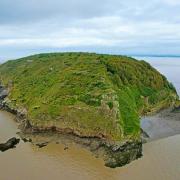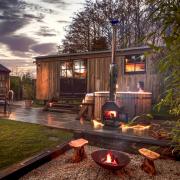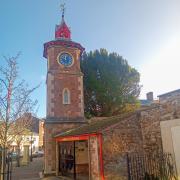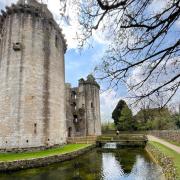From Brean Down to Burnham-on-Sea there are seven miles of beach - so what can you do there? You can go land yachting of course. I met up with Derek George at the Brean Land Yacht Club, not much more than a portacabin plus storage unit but somewhere to keep warm, have a cup of coffee and meet other enthusiastic members. Derek is a former British Champion; he introduced his son to the sport at the age of 12 and now Craig is the current champion.
The activity can be traced back to 6th century China and it came to Brean in the 1920s when the locals would make the vehicles from the remains of World War One aircraft. Now it is recognized as one of the best European beaches with two Regattas a year. Derek said: ‘This is a good beach in general, it’s flat, it’s quite hard sand and we’re well positioned for south westerly winds and that comes straight on the shore here and that makes perfect sailing.
‘I get as much buzz out of doing this as racing motor bikes. You can get the adrenalin going, being low to the ground and going at speed. If you’re doing 35 you feel as if you’re doing 60. The other enjoyment out of it is the eco-friendly thing, you’re not actually using fuel, just using the power of the wind to give you that adrenalin feel.’
The ‘yacht’ looks like a sophisticated go-kart frame with three wheels and a sail. It is, but it can go up to 65mph, is classified as an extreme sport and there are no brakes (don’t worry you just sail into the wind to stop). Wind speed is important, you need at least 10mph and generally you can go at about twice the strength of the wind. ‘Hiking’ is when you go on to two wheels, apparently it is a fun factor but you do lose speed.
‘We have had higher numbers in the past but we are losing the younger generation because they’re on computers and play stations. We’re looking to encourage the younger ones for sure. If anyone’s interested in joining the club we do taster days and we have got club yachts here so they have got use of them for a year. Come and try it, we guarantee you’ll be smiling very soon.’
Donning a helmet, I had a short go, it was truly amazing – I shall return with my son for a taster session.
The Morrison’s cashier confirmed that Brean was indeed a village of two seasons; population down to under seven hundred in winter months with a shop, a chippie and a pub, but in the summer with the small city of caravans and chalets, people swell into the thousands (land sailing is not permissible in July and August). The numbers game is further complicated by the fact that EDF have taken over the Pontins site for 900 Hinkley workers.
Martin Chatterton, chair of the Parish Council, has had a working life at sea so it’s not surprising he moved to Brean 23 years ago. ‘My house opens onto the beach so I can get up in the morning open the gate and I’m on the beach. That is wonderful, that’s the reason I moved here. I can see the sun rising over the Mendips in the morning and I can see it set over the Bristol Channel, depending on the time of year, anywhere from Cardiff in the summer down to over Exmoor in the winter.’
On a bright Sunday, even out of season, the National Trust car park will be full and there’ll be a row of cars on the beach (tide permitting); there will be dog walkers, hardy fishermen, children playing, horse-riders, husky club members, kite buggies and of course land yachts. It’s a giant pleasure park.
The Fort/Palmerston Folly
Take a walk up the hill and a stroll along the unspoilt beautiful Brean Down peninsular with spectacular views and you find the fort. It’s a kind of unintentional folly. Built and manned during the Victorian era to stem a potential French invasion, then re-commissioned during World War Two to keep the Germans out, the fort never actually saw any conventional action. It was one of four spanning the Bristol Channel the others being on Flat Holm, Steep Holm and Lavernock Point in Wales. Seven large guns were installed at the battery but they soon became largely redundant. In 1900 a soldier fired his rifle into a gunpowder magazine and that ended this particular military occupation. It was re-garrisoned in WWII with naval guns from WWI ships and a huge generator to power searchlights; nothing was seen and the guns never fired in anger. However, the isolation of the spot did make it suitable for some experimentation by the Admiralty’s Department of Miscellaneous Weapons Development. A seaborne version of the bouncing bomb was tested here, as were torpedo decoys and rocket grappling irons. The National Trust took it over as a managed ruin.
Tides
Geographically, Brean's claim to fame is that it has one of the greatest tide ranges in the world, second only to the Bay of Fundy in Canada.
The sea has some strong and dangerous currents at low tide and red warning flags should be observed.
INFO
Population: 635 (2011 census)
WHERE TO STAY: The Old Rectory is a seasonal (from March) family run bed and breakfast just 400m from the beach. The property is situated in the quieter centre of Brean but is within walking distance of the main attractions. It has an acre site, including attractive gardens, fish pond and play area; also adjacent to the beautiful medieval St.Bridgets Church. The property benefits from a licenced bar in its conservatory and a private partially walled garden. admin@oldrectorybrean.co.uk



























